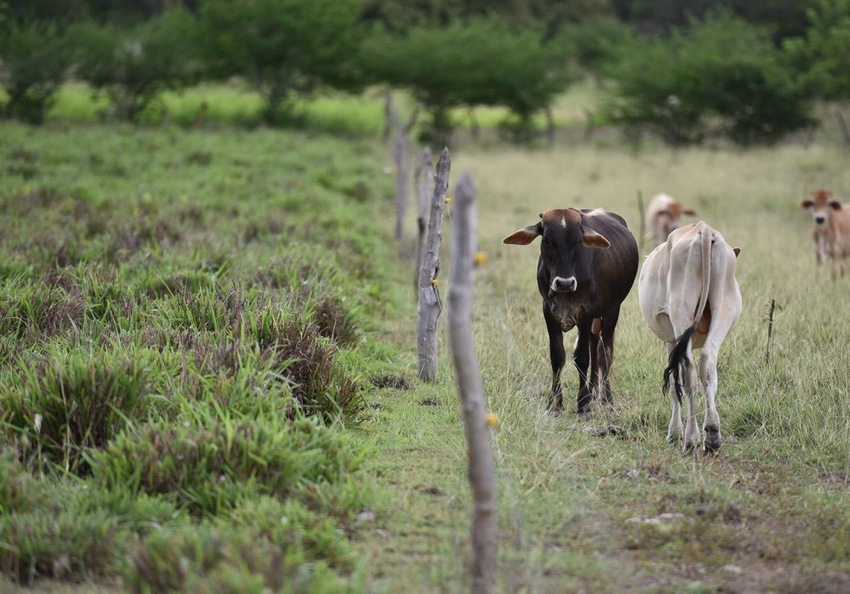When cow urine falls on degraded land, it releases more nitrous oxide than when absorbed by healthy pasture.
January 31, 2019

While the role of the greenhouse gas methane from cattle has been studied much more, cattle urine may also contribute to greenhouse gas emissions through nitrous oxide, which has warming power far greater than that of carbon dioxide, the common metric for global warming emissions.
A study conducted by the International Center for Tropical Agriculture (CIAT) and partners shows that nitrous oxide emissions from grazing cattle may be significantly curbed by healthy pastures.
For the study, researchers collected urine from cattle at research sites in five countries across Latin America and the Caribbean. They spilled these 500 mL samples on paired cattle fields classified as degraded or healthy, which was determined by vegetation coverage, CIAT said in an announcement. In six of the seven test sites, degraded pastures emitted significantly more nitrous oxide — sometimes up to three times as much. The results were published Jan. 29 in Scientific Reports, an open-access journal by the publishers of Nature.
"Degraded pastures are bad in so many ways," said Ngonidzashe Chirinda, a CIAT researcher and the study's lead author. "This study adds to the case for land restoration. Degraded pastures not only affect food security and the livelihood of farmers today but affect the livelihood of future farmers because they emit more gases that cause global warming."
Estimates vary, but Chirinda calculated, conservatively, that there are 150 million hectares of degraded lands in Latin America. Brazil alone may have close to 80 million hectares of degraded pastureland.
Degraded livestock land is generally characterized by overgrazing, soil compaction, loss of organic material and low levels of nutrients and soil carbon, CIAT said. Large-scale land restoration with improved forage grasses, rotational grazing and the addition of shrubs and trees (i.e., silvopastoral farming) could significantly mitigate the negative climate effects wrought by degradation. In addition to reducing nitrous oxide emissions, restored landscapes generally contain more carbon, have healthier soils and more robust and productive livestock, CIAT said.
The curious results from the single test site that did not align with the study results — in Taluma, Colombia — may be attributed to a number of factors that merit further research, according to CIAT. Nitrous oxide emissions there were by far the lowest at any test site and were the same on both degraded and healthy pastures. The cattle urine used in the experiment had the lowest nitrogen content compared to the other research sites, which likely contributed to the results, the organization said, noting that the forage grass used there, Brachiaria humidicola, also has an especially high nitrification inhibition capacity, meaning that it prevents nitrogen from becoming nitrous oxide.
Better cattle greenhouse gas estimates
Researchers said the study is a useful step toward creating a more detailed picture of the scope of greenhouse gas emissions from cattle farming in Latin America and the Caribbean.
"Since work on emissions from livestock in the region is not common, this study generates at least one piece of information that is missing from theoretical greenhouse gas estimates in the region," said Miguel Andrés Arango, a co-author and scientist at Colombia's AGROSAVIA, the nation's largest agriculture research organization.
"Being able to estimate the real impact of cattle production will allow us to propose potential practices for reducing emissions," Arango said.
Collaborators on this project included researchers affiliated with the following organizations: the National Autonomous University of Nicaragua; National Institute of Agricultural Technology in Argentina; Federal University of Rio Grande do Sul, and Institute of Agriculture & Forestry Management & Certification in Brazil; University of the West Indies in Trinidad & Tobago; Universidad Nacional de Colombia; U.S. Department of Agriculture, and University of Vermont.
Source: International Center for Tropical Agriculture, which is solely responsible for the information provided and is wholly owned by the source. Informa Business Media and all its subsidiaries are not responsible for any of the content contained in this information asset.
You May Also Like


.png?width=300&auto=webp&quality=80&disable=upscale)
